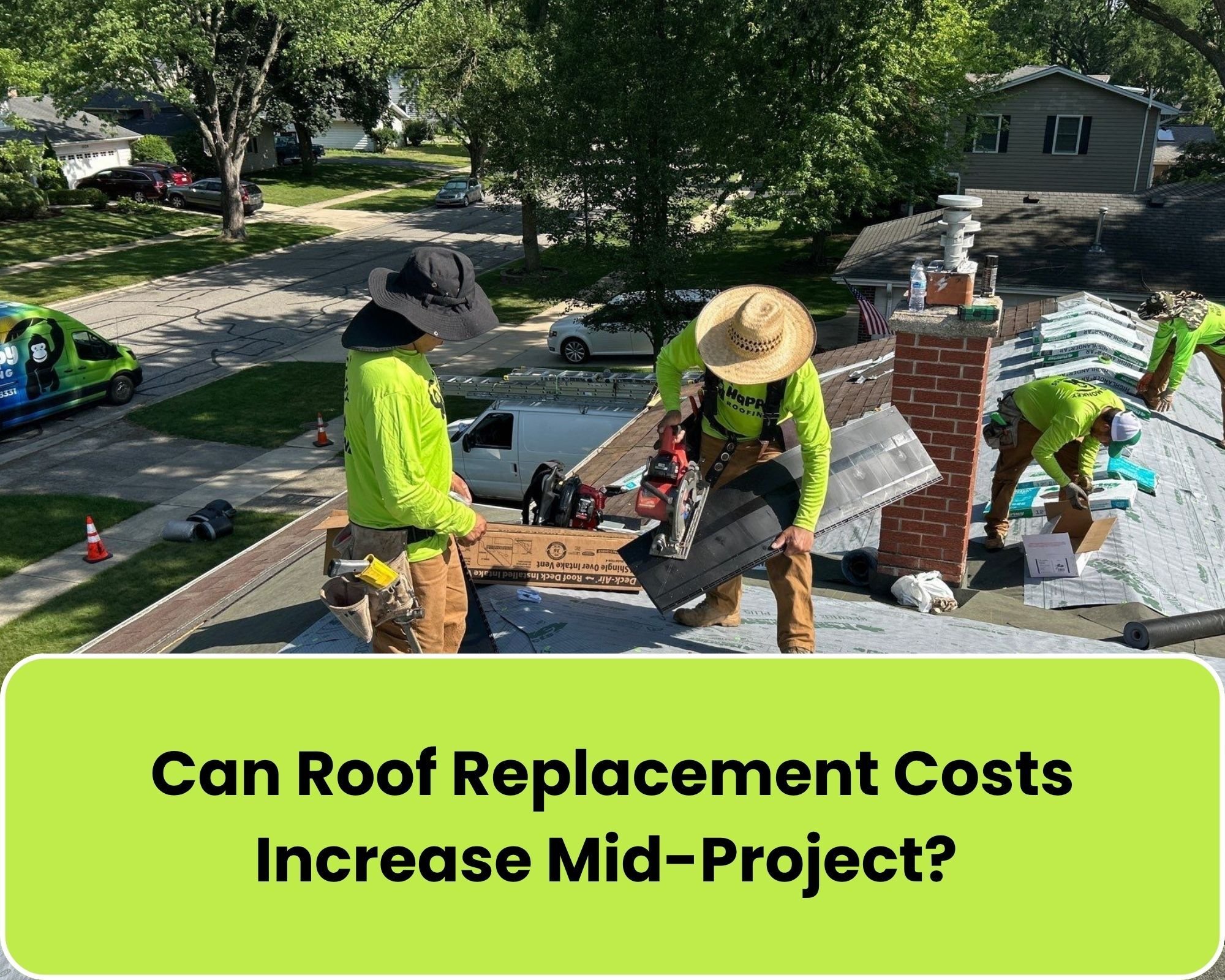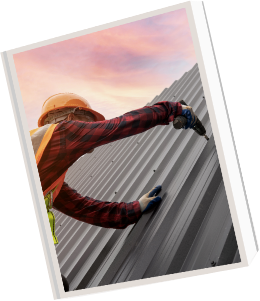Can Roof Replacement Costs Go Up After the Tear-Off? Here's What to Expect

If you're preparing for a roof replacement, one of the biggest worries you might have is: Will the price go up after work begins?
It's a fair concern. The thought of signing a contract only to be hit with unexpected charges later makes most homeowners uneasy. It's true that in some cases, additional costs do come up once the old shingles are removed. While no roofer can predict the exact possible price change, understanding the variables ahead of time helps you avoid being caught off guard.
At Happy Roofing, we've guided hundreds of homeowners across Naperville through this exact process. We understand that the unknowns behind a roofing project can feel stressful, and we believe homeowners have the right to know what to expect before agreeing to partner with any roofing contractor.
This article will walk you through why roof costs can increase after a tear-off, what price changes are considered normal versus unusual, and how a trustworthy roofer should prepare you for those possibilities upfront.
Table of Contents:
- What Causes Roof Replacement Costs to Go Up After Work Begins?
- What Added Roofing Costs Are Red Flags?
- How Contractors Should Communicate the Possibility of Cost Variables
- Can You Avoid Added Roofing Costs?
- How to Spot an Accurate Roofing Estimate
What Can Cause Costs to Go Up After the Tear-Off?
Roof replacement costs can increase after the tear-off if additional hidden problems are revealed. These problems aren't completely visible until the old shingles and underlayment are removed.
While uncovering hidden issues can be frustrating, knowing about these possibilities ahead of time helps homeowners plan realistically and avoid feeling blindsided. Finding and fixing these underlying issues now protects your home from larger, more expensive concerns down the road.
Here are the most common reasons costs may rise after a tear-off:
- Hidden Wood Rot or Decking Damage: When shingles and underlayment come off, contractors sometimes find rotted or softened roof decking caused by long-term leaks or poor attic ventilation. This damaged wood (whether plywood or Oriented Strand Board) must be replaced to ensure shingles are properly fastened and the roof remains structurally sound.
- Multiple Layers of Shingles Discovered: Some homes may have more layers than expected, due to roof overlays completed in the past. These extra layers can't always be identified before tear-off, but each additional layer adds labor, time, and disposal costs. From our perspective, it's critical to remove every layer of roofing because you can't properly replace all roofing components (like decking and underlayment) otherwise. Leaving existing materials can trap problems underneath and lead to premature failure of your new roof.
- Flashing Replacement: The existing flashing typically needs to be removed to replace the roof, and it can be damaged during a tear-off. If rusted, worn, or damaged flashing is reused, it can lead to leaks. We replace all existing flashing when we do roof replacements, and include it on our quotes, but not all contractors do this.
- Structural Issues: A tear-off can reveal sagging rafters, cracked trusses, or other framing problems that weren't visible from the attic or roof surface. While rare, these structural issues need correction before a new roof can be safely installed.

What Additional Roofing Costs Could Be Red Flags?
What homeowners need to watch for are unusual or inflated charges that don't match the work being done. It's normal for roofing costs to increase after a tear-off if hidden problems are discovered. Most of the time, these added costs are reasonable and reflect necessary repairs to protect your home.
The key is looking for documentation that helps explain why these changes are being made, and why you're being charged for them. If a roofer adds costs without a clear explanation or proof, that's when you should start asking questions.
What Are Some Examples of Dishonest Roofing Price Hikes?
Dishonest roofing price hikes usually show up as vague, inflated, or undocumented charges that don't match the actual work being done. If you're suddenly told that over half of your roof needs new decking without photos or documentation, it could be a sign that the contractor is untrustworthy.
Most roofers are honest about added costs, but there are situations where homeowners should be cautious.
Common roof replacement pricing red flags include:
- Vague lump-sum charges: Extra costs listed without detail, such as "additional repairs – $1,000", make it impossible to know what's being done. Your contractor should be able to walk you through why these extra costs are needed and provide documentation showing the work that's been completed.
- Sudden "emergency" upgrades: Being told you must immediately upgrade materials or ventilation, without clear code references or visible evidence that your roof needs them, can be a sign of dishonest change orders.
- Pressure tactics: Claims that work must continue right away and can't be paused for you to review photos or documentation, pressuring you into blindly agreeing to change orders are immediate red flags.
How Should Roofers Communicate About Potential Extra Costs?
A trustworthy roofer should be transparent about potential extra costs before the project begins. While they can't predict every hidden issue, they should explain the most common scenarios, outline how additional work will be priced, and commit to documenting anything they find after the tear-off.
How a Trustworthy Roofing Contractor Prepares You for Unknowns
Your roofer should clearly explain that certain issues, like warped decking or ventilation problems, may only become visible after the tear-off. They should also walk you through what those fixes typically cost, so you know what's reasonable if they come up later.
Here's what proactive communication looks like:
- Discussing common scenarios upfront: Explaining the most likely hidden issues, and what they could cost to fix, helps set the right expectations and avoid unwelcome surprises.
- Itemizing variable costs in the estimate: Including line items such as "decking replacement (per sheet)" gives clear insight into exactly how much the cost could fluctuate.
- Committing to documentation: Providing photos or video proof of why the extra work is needed, and updated photos during the process, builds trust and ensures your money is going where it should be.
- Setting cost ranges in advance: Outlining normal ranges (e.g., $75–$150 per sheet of decking) so you can quickly spot a red flag if pricing seems inflated.
This proactive communication keeps homeowners informed, prevents surprises, and builds trust from the start. Below is an example of how we include variable costs in our estimates:

Can You Avoid Surprise Roofing Costs After the Tear-Off?
You can't eliminate every unknown, but you can reduce surprises by making sure your roofer does a thorough inspection before the project starts. Upfront communication and asking the right questions go a long way in helping you understand what to expect.
What Hidden Problems Should a Thorough Roof Inspection Catch?
A thorough roof inspection should catch signs of the most common problems that drive up costs after a tear-off. While not every hidden issue can be verified until work begins, a careful contractor can spot early warning signs and help you prepare for potential cost changes.
- Lack of attic ventilation: A proper roof inspection should include attic access (whenever possible) to identify visible signs of decking rot or mold growth, both of which are common ventilation problems.
- A thorough contractor will also calculate your home's specific ventilation requirements using tools like this ventilation calculator. It helps determine whether your home may need additional vents, ensuring your roof lasts as long as possible and retains its manufacturer's warranty (signs of poor ventilation could void most manufacturer-provided warranties).
- Signs of structural issues: Multiple shingle layers can't always be verified, but walking the roof could reveal soft spots that could point to worn decking, hinting at the need for replacement. While not every hidden issue can be predicted, many of the most common cost drivers can be flagged ahead of time.
Questions to Ask Before You Sign the Contract
If you feel that you're contractor isn't being as transparent or thorough as they could be, don't be afraid to ask any questions that could help you understand everything before agreeing to any work.
To avoid surprises, ask your roofer:
- How do you handle hidden damage if it's discovered?
- Will you itemize common repair costs in the estimate?
- What documentation will you provide if additional work is needed?
Getting these answers upfront helps you feel confident in your roofer's process and avoids confusion if costs do change once work begins.
How to Identify a Thorough Roofing Estimate
When your roofer explains common variables upfront, provides itemized pricing, and documents any additional work with photos, you stay in control of your project and your budget. Roof replacement costs can go up after a tear-off, but that doesn't have to come as a surprise.
Transparency is the key to trust. That's why we walk every homeowner through potential scenarios before work begins and provide clear proof if unexpected repairs are needed.
Want to learn exactly how we build clear, honest estimates? Read our next article, How Happy Roofing Builds an Honest Roofing Estimate: And How to Spot Red Flags. It's meant to provide insight into how thorough quotes are built, so you can compare estimates in confidence.
If you'd like a professional assessment of your roof's health, we offer no-commitment inspections to explain your options clearly with no expectation for you to partner with us.
The Author: Pedro Toledano
Happy Roofing is a trusted roofing company dedicated to providing top-quality roofing services to residential and commercial clients. With years of experience, they specialize in roof installations, repairs, and maintenance, ensuring durability and customer satisfaction. The team is known for their professional approach, timely service, and attention to detail. Happy Roofing prides itself on using high-quality materials and offering competitive pricing. Follow their Facebook page for updates on projects, customer testimonials, and tips on maintaining your roof in excellent condition.





